 |
||
|
||
| ||
Thermaltake is a flagship on the market of processor coolers worldwide. But today, when this company is persecuted by such companies as Titan Computer and Elan Vital, its star is shining not so bright. Thermaltake, however, is not going to lose the palm of supremacy and is constantly updating its model row, while following a quite aggressive price policy. Today we will take a look at two relatively new coolers from Thermaltake - Volcano II and Mini Copper Orb. The Volcano II was announced at the beginning of this year almost simultaneously with Super Orb, while the Mini Copper Orb was introduced at the end of March. The coolers will be tested according to our rather rough technique. Starting from this review we will conduct not only temperature tests, a noise level will be also estimated, since exactly processor coolers are a main source of noise in computer systems. Characteristics and first impressions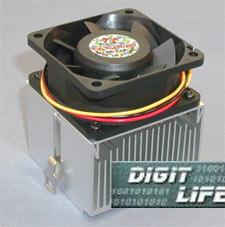 Volcano II (model DU0462-7)
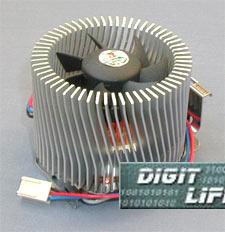 Mini Copper Orb (model DU0462-9)
The Volcano II is a classic cooler for Sockets 462 and PGA370. It has an aluminum extrusion standard heatsink, a usual fan and a convenient mount. The heatsink has thin fins (the thickness near the base is 1 mm, on the top - 0.7-0.8 mm, the height is 34 mm in the central part of the heatsink and the distance between neighbor fins is 2 mm). The console coefficient is equal to 17:1. For the extrusion technology such ratio is very good. The heatsink fins become smaller to the edge of the heatsink. Such construction is caused not by economy of material. Almost any heatsink can be characterized by such parameter as finning efficiency, which equals the ratio of a heat stream dissipated by the fin to the heat stream coming from the base of the fin. As a rule, the heat stream is concentrated in the central part of the heatsink, but the ventilation conditions of fins are different (on the edges fins are cooled better). That is why such configuration boosts up the efficiency of the heatsink. But in a powerful heatsink such configuration is not rational. The fan is mounted on an aluminum frame attached to side fins of the heatsink with clamps. On the one hand, the fans are not loaded with the fan. But on the other hand, these clamps are too fragile and can make increase vibration and noise. But during the tests the Volcano II didn't make much noise. And what about the Mini Copper Orb? 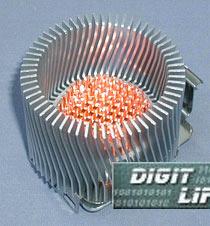 The base of the heatsink is a copper cylinder with pinned surface on the upper end. An external 60-fin contour is made of aluminum. Copper has a much higher coefficient of heat conductivity than aluminum, that is why effectiveness of such heatsink must be better as compared with an aluminum heatsink of the Chrome Orb. And the tests verified it. Besides, the cooler has obtained a more compact size. An external diameter of the heatsink is reduced to 64 mm (by 5 mm as compared with the Chrome Orb). 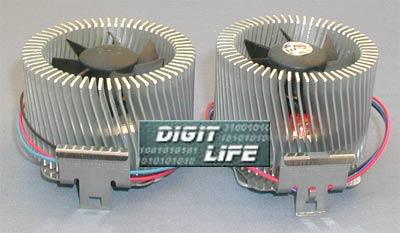 But the heat exchange surface hasn't reduced in size. Although the fins have become thinner by 2 mm, they have grown by 5 mm (45 mm against 40 mm of the Chrome Orb). The reduced diameter of the heatsink makes the installation of the Mini Copper Orb on Socket A motherboards easy (for example, Abit KT7). 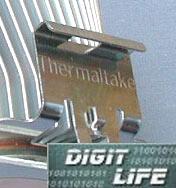 The cooler's mount has also undergone changes. It acquired an additional catch for the screwdriver and a respective notch in the hand of the clip. This catch doesn't help much in installation, but it is very useful in demounting. Although it's not difficult to demount a cooler by pressing the hand of the clip, the applied force is too large and, therefore, dangerous for a processor's core. With the screwdriver the force becomes much less. InstallationNow let's come back to the Volcano II. Its heatsink's base has a cut on one of its sides. 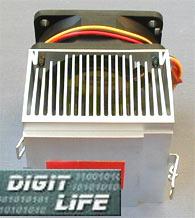 The way to avoid problems with installation into the PGA370 is very curious! This socket has a tricky lock preventing installation of heatsinks whose base is larger than 55 mm. But the Volcano II can be mounted on almost any motherboards with the PGA370 socket and on any adapter PGA370/Slot1. Besides, standard dimensions of the Socket 462 makes the problem of installation of the Volcano II onto AMD based boards minimal. As a result, we have a universal cooler whose geometry and light weight (170 g) create no problems either for PGA370 socket or for Socket 462. An ordinary fastening clip has a standard catch for a screwdriver. The clip is relatively weak, and the force of pressing the heatsink to the processor's core is not dangerous. The installation of the Mini Copper Orb was already described in the previous section, and drawing the conclusion I want to attract your attention to the following aspects: the cooler is easy to install and demount on the most of motherboards with Socket 462. The PGA370 socket won't prevent installation as well (including PGA370/Slot1 adapters). TestsLet's start with stress-tests. Both the fan of the Volcano II and the one of the Mini Copper Orb performed rather good. At 17V both impellers warmed up significantly (what means excessive consumed power). At 5V the fan of the Volcano II worked stable. But the one of the Mini Copper Orb worked irregularly with the vibration increased. The fans warmed up much when the impeller was idle for a long time. Having opened the case we found out that the gap between the axle and the bearing didn't meet the requirements (0.4-0.5 mm), the size and quality of grease were normal, and the quality of mounting of the components of the card were satisfactory. The impeller speed was almost as prescribed. Now are the temperature tests. The test system configuration includes:
The CPUBurn packet is used for good warming-up of the processor, and the MBProbe 1.30 utility is used for temperature control. Temperature measurements 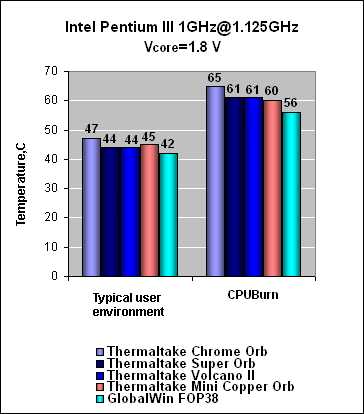 Notes At last, you can look at the results of noise measuring. We used a sound level meter Bruel&Kjaer Type 2203 with an additional octave filter set Type 1613. For detailed examination of noise characteristics of the coolers we measured not only sound level LA (A-weighted), but also sound pressure level for octave bands Noise level measurements 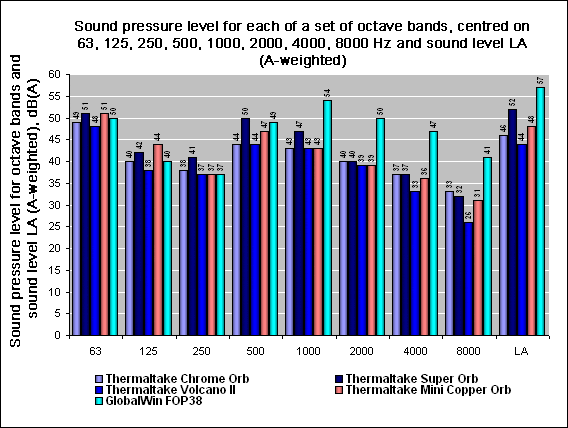 Notes The permissible noise level at work places, living quarters, public buildings in case of scientific activity, programming etc. mustn't exceed 50 dBA according to the Standard. Our measurements show that the acoustic parameters of the Volcano II and Mini Copper Orb do correspond to the norm. ConclusionThe Thermaltake Volcano II and Mini Copper Orb coolers have a good design, high cooling efficiency, are convenient and easy to install/demount. The noise level is also low. The price/quality ratio is one of the best on the market. The Volcano II and Mini Copper Orb will be a good
purchase for those who want to save, but not at the expense of reliability
and performance of their computers.
Write a comment below. No registration needed!
|
Platform · Video · Multimedia · Mobile · Other || About us & Privacy policy · Twitter · Facebook Copyright © Byrds Research & Publishing, Ltd., 1997–2011. All rights reserved. |